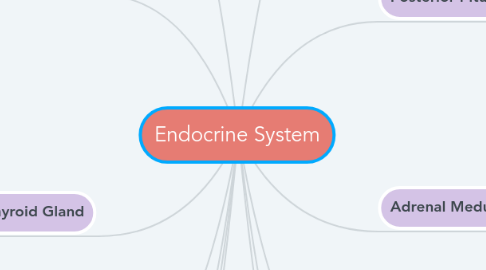
1. Hypothalamus
1.1. Corticotropin-releasing hormone
1.1.1. Rgulates ACTH secretion
1.2. Gonadotropin-releasing hormone
1.3. Somatostatin
1.4. Growth hormone-releasing hormone
1.4.1. Control GH secretion
1.5. Prolactin release-inhibiting hormone
1.5.1. Restrains secretion of Prolactin
1.6. Thyrotropin-releasing hormone
1.6.1. Regulates TSH secretion
2. Thyroid Gland
2.1. Calcitonin
2.1.1. Secreted by extrafollicular cells
2.1.2. Lowers blood calcium and phosphate levels
2.2. Thyroxine
2.2.1. Increase metabolism, protein synthesis, and stimulate lipid breakdown
2.2.2. Needed for growth and maturing nervous system
2.3. Triiodothyronine
2.3.1. Increase metabolism, protein synthesis, and stimulate lipid breakdown
2.3.2. Needed for growth and maturing nervous system
2.4. Located in the neck
3. Parathyroid Gland
3.1. Parathyroid hormone
3.2. Located on posterior surface of thyroid gland
3.3. Increases blood calcium ion and decreases phosphate ion concentrations
3.4. Stimulates resorption of bone tissue
4. Pancreas
4.1. Glucagon
4.1.1. Stimulates liver to make glucose
4.2. Insulin
4.2.1. Activates facilitated diffusion
4.3. Somatostatin
4.3.1. Inhibits glucagon and insulin release
4.4. Located posterior to stomach and attached to small intestines
5. Pineal Gland
5.1. Melatonin
5.1.1. Regulation of Circadian Rhythms
6. Testes
6.1. Testosterone
7. Thymus
7.1. Thymosins
7.1.1. Increase specific white blood cells
7.2. Posterior to sternum between the lungs
8. Anterior Pituitary
8.1. Prolactin
8.1.1. Stimulates breast growth and milk production
8.2. Follicle-stimulating hormone
8.2.1. Affects reproductive organs
8.3. Lutenizing hormone
8.3.1. Affects reproductive organs
8.4. Thyroid-stimulating
8.4.1. Controls secretions of hormones from thyroid gland
8.5. Adrenocorticotropic hormone
8.5.1. Controls the secretion of certain hormones from the adrenal cortex.
8.6. Growth hormone
8.6.1. Stimulates body cells to grow and divide
8.7. Attached to base of brain
9. Posterior Pituitary
9.1. Antidiuretic hormone
9.1.1. Causes kidneys to excrete less water
9.1.2. Regulated by hypothalamus
9.1.3. High concentrations constrict blood vessels
9.2. Oxytocin
9.2.1. Contracts smooth muscle in uterine wall
9.2.2. Contracts certain cells associated with milk production and release
9.3. Attached to base of brain
10. Adrenal Medulla
10.1. Norepinephrine
10.2. Epinephrine
10.3. Located atop the kidneys
10.4. Effects of hormones similar to sympathetic nervous system
10.5. Hormones synthesized from tyrosine
11. Adrenal Cortex
11.1. Aldosterone
11.1.1. Causes kidneys to preserve water and sodium and excrete potassium ions
11.1.2. Maintains blood volume and pressure
11.2. Cortisol
11.2.1. Inhibits protein synthesis, releases fatty acids, and stimulates glucose formation
